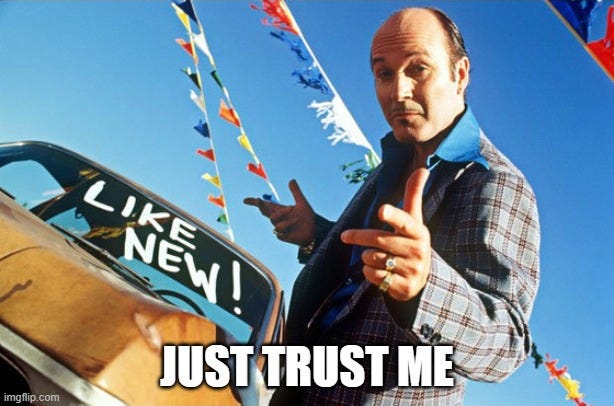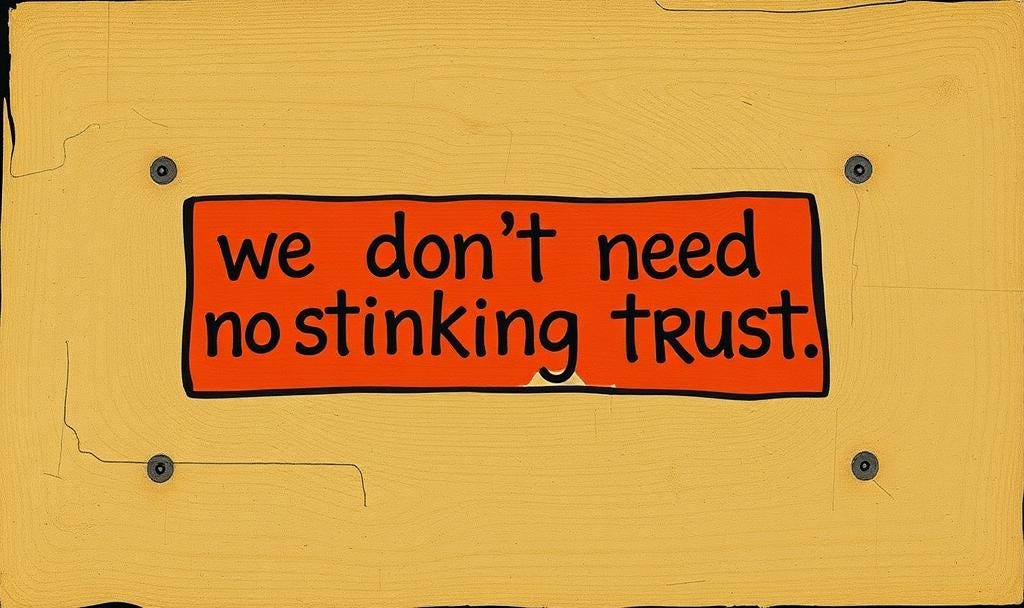Is There an ROI From Building Trust? Yep
Do you buy from people you don't trust? Do you think your customers do? Trust is a competitive edge; hone it.
We all know we buy from people and companies we trust. We feel it. We live it.
I bang on about the value of trust often.
But that always felt a little “squishy” to me to link increased trust with revenue (and a little gross too).
So I finally decided to see if there is any research that links trust to increased revenue or other metrics of success.
Turns out: yes.
Here’s a quick spin through the research and the implications for your business.
Why It Feels Icky
Writing about the ROI of trust feels gross. Like weaponizing sincerity. Marketing designed to trick someone into buying from you is just propaganda with a quarterly earnings call attached.
But here’s the line I’ll draw: the difference between propaganda and marketing is intent.
So, for this piece, let’s assume two things:
You actually, truly, deeply give a shit about your customers.
You deliver products and services that help them succeed.
If those two aren’t true? Stop reading. If they are — let’s see what the numbers say.
Trust Moves Revenue
The numbers aren’t subtle.
PwC (2024): 46% of consumers purchased more from trusted companies; 28% paid a premium; ~40% walked away after trust broke.
Edelman (2019–2020): 81% say they must trust a brand to buy. High-trust buyers are 2× more likely to stay loyal and 2× more likely to try new products. 75% will pay more.
Forrester (2023): Trust predicts willingness to repurchase, try new offerings, and even share personal data.
Examples:
Datamax Texas: A former client, they focus on creating “Raving Fans.” They measure this with a Net Promoter Score variation. Their average score since 2012 is 93.2. World class customer loyalty and “would you recommend” measurement is over 75%. This copier company (an industry often trusted at the same level as used car dealers) has 9 out of 10 customers willing to recommend them because they focus on the basics of great service: communication, fixing issues, and well-trained employees.” They bake trust into their business model. Read more.
Patagonia: Trust translates into price elasticity. Patagonia can charge more than competitors selling similar jackets, because customers believe the company means what it says about sustainability. And that belief fuels repeat purchases.
Amazon Prime: People trust the system will deliver (literally). That trust—two-day shipping actually means two-day shipping—keeps over 200 million people locked into subscriptions. Though as Amazon adds more and more ads across their services, trust is bending for consumers (me included).
Trust isn’t just something you can feel good about. It has a direct link to customer loyalty, lifetime value, and referrals.
Two more stats; one that shows the revenue benefits of building trust and the other that reflects how important it is for employees to trust company leadership.
BCG Henderson Institute (2022): The Top 100 most trusted companies delivered ~25% CAGR in total shareholder return (2019–22). The global index? 10%. That’s 2.5×.
Great Place to Work (2025): High-trust workplaces generate 8.5× more revenue per employee and have outperformed the market by 3.5× over nearly three decades.
Don’t forget employee trust. Without that foundation, it’s going to be harder for you to generate trust from customers. Gallup data shows only 23% of employees strongly trust their leadership—but when they do, engagement, energy, and retention soar. Internal trust lowers turnover, one of the biggest hidden costs for any business, especially SMBs. A workforce that trusts leadership shows up harder, stays longer, and delivers better experiences to customers.
Employee trust is a hidden competitive advantage.

The Trust Gap
Most executives assume customers already trust them. Data says otherwise.
PwC (2024): 84–95% of executives think customers highly trust them. In reality? Only 27–52% of customers agree.
Salesforce (2024): Only 42% of customers trust businesses to use AI responsibly (down from 58%).
IAB/PureProfile (2024): In cost-of-living crunches, 62% of shoppers switch to cheaper brands—even trusted ones.
Let’s use Meta as an example. Billions of users, but very low trust. Cambridge Analytica permanently damaged brand credibility. Yet users stay because of network effects, not trust. I would gladly leave Facebook for nearly ANY similar alternative.
You can’t bank on trust if you don’t actually have it. Don’t delude yourself into believing your customers trust you.
Trust!?!? Meh, Who Cares!
Not everyone buys the “trust pays” story.
Trust is overrated in commoditized markets. In categories like gas stations, airlines, or generic groceries, convenience and price often beat trust. You may not trust Spirit Airlines — but you’ll still book the $49 fare. Though probably only once (my experience) as the “here a little slice, there a little cut” approach to additional fees adds up quickly.
Mistrust can be profitable. Some businesses thrive despite lack of customer trust because there is no other choice. Think payday loans, bail bonds, or cable companies. They profit off stickiness, not loyalty.
High trust can breed complacency. When companies believe their customers will stick around no matter what, they risk underinvesting in innovation. Kodak trusted its brand too much (who else remembers or still says “Kodak Moments”?) — and missed the digital camera wave (even as one of their engineers had invented the digital camera — Kodak leadership shelved it because they didn’t want to hurt film sales).
My take: these arguments aren’t wrong from a sucking in revenue point of view. They do show tunnel vision. Trust may not win every transaction, but it builds durability. Lack of trust may drive profits in the short term, but it’s a fragile model — one competitor with trust equity can collapse it overnight.
A Multiplier, Not a Mirage
Here’s the takeaway: trust is not a fuzzy halo. It’s measurable. It’s a multiplier.
And it’s not new. Trust has always been economic glue. In medieval Venice, merchants built systems of “letters of credit” based purely on personal trust long before modern banking existed. Entire trade networks rose and fell on reputation. Trust isn’t a trend — it’s the lubricant of a great business model.
Customers spend more.
Investors reward it.
Employees are more productive.
The market forgives mistakes faster.
If it’s real, trust is compound interest.
So:
If you care, show it.
If you deliver, prove it.
If you’re in it for the long haul, build the systems and culture that sustain it.
Because trust has an ROI. And the numbers say it’s too big to ignore.
Build Trust You Can Measure
If trust compounds like interest, your newsletter is the account it grows in.
A good newsletter is about showing up with useful ideas, week after week, until readers stop seeing you as a marketer and start seeing you as a partner.
That’s what my Newsletter-in-a-Box services helps you do:
Launch a newsletter that builds familiarity and credibility from day one.
Turn consistency into trust — and trust into customers who come back.
Skip the tech headaches; focus on the human connection.
👉 Learn more about Newsletter-in-a-Box — and start turning trust into ROI. Or drop me a line now, bryant@simplyusefulmarketing.co, and let’s have a quick chat.
Musical Inspiration/Listened to While Writing
For my fellow Les Mis fans, you probably recognized the line earlier, “here a little slice, there a little cut.” For those of you who’ve not seen the movie or the musical; the Thenardiers are NOT to be trusted!
We’ll end with Michael Crawford and my favorite musical.





Dunno which I love best, the research-backed stats or music recommendations - an absolute change of scenery. Also, "build trust you can measure." I've realized that, unlike the 2-min noodle post or notes (no offense to them), Newsletter/long form provides space for anyone to go beyond helpful to essential. That's why I'm focusing on building that depth.
I think (hope) people are waking up to the fact that Substack isn't about building connections, it's about building relationships.
And what's the key component of a successful relationship? Both people trust one another. Keep bangin' that drum, brother!